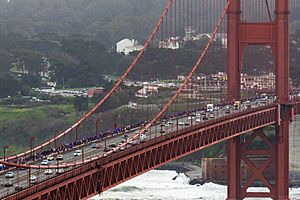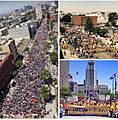Protests against Donald Trump facts for kids

Protests against Donald Trump were events where people gathered to show their disagreement with Donald Trump. These protests happened in the United States starting in 2016. People protested during his run for president, known as the Trump presidential campaign. They also protested after he won the 2016 presidential election.
During his campaign, some people, called activists, organized smaller protests. These often took place inside Trump's own rallies. Sometimes, these groups even tried to stop the rallies from happening.
After Donald Trump won the election, many more people joined in larger protests. Students and other activists gathered in big cities across the United States. They often chanted slogans like "Not my President!" to show their feelings.
Contents
Understanding Public Protests
Protests are a way for people to express their opinions. They can show support or disagreement with leaders or government decisions. People often protest when they feel strongly about an issue. These gatherings are a part of democracy, allowing citizens to have their voices heard.
Why People Protested Donald Trump
People protested Donald Trump for different reasons. Some disagreed with his ideas and policies. Others were upset about things he said during his campaign. The protests grew bigger after he won the election. Many people felt worried about the future of the country.
Protests During the Campaign
Before the election, some people protested at Trump's campaign events. These protesters were often activists who disagreed with his views. They would sometimes try to interrupt his speeches. Their goal was to draw attention to their concerns. These early protests showed that there was strong opposition to his campaign.
Protests After the Election
After Trump won the 2016 election, the protests became much larger. Many people were surprised by the election results. Thousands of students and activists gathered in major cities like New York, Los Angeles, and Washington, D.C. They marched and held signs to show their disappointment and concern.
The Women's March
One of the biggest protests was the Women's March. This happened on January 21, 2017, the day after Trump became president. Millions of people, mostly women, marched in cities all over the world. The main march was in Washington, D.C. People marched for women's rights, human rights, and other causes they felt were threatened. It was one of the largest single-day protests in U.S. history.
Other Major Protests
Many other protests followed the Women's March. These included demonstrations against Trump's policies on immigration and environmental protection. For example, there were protests against his travel ban from several Muslim-majority countries. People also marched to support immigrants and refugees. These events showed ongoing public disagreement with the new administration.
Protests Across the World
Protests against Donald Trump were not only in the United States. People in other countries also organized demonstrations. They showed their support for American protesters and expressed their own concerns about Trump's policies. These global protests highlighted that his presidency had an impact beyond the U.S. borders.
Images for kids
-
Day Without Immigrants protesters in Washington, D.C.
-
Not My Presidents Day demonstrators en route to the White House, Washington, D.C.
-
Day Without a Woman protesters in front of San Francisco City Hall
-
Tax March protesters at the U.S. Capitol
-
Protestors against Trump recall abolitionist John Brown. Greensboro, N.C., October 7, 2017.
-
Activists in Manila burn rotating Trump effigy, dubbed "Fascist Spinner", inspired by the fidget spinner
-
Family separation policy protest in Phoenix, Arizona
-
Baby Trump balloon flown in Parliament Square, Westminster, London, July 2018
-
Baby Trump and Stop the Hate poster, Place de la République, Paris, November 2018
See also
 In Spanish: Protestas contra Donald Trump para niños
In Spanish: Protestas contra Donald Trump para niños


















